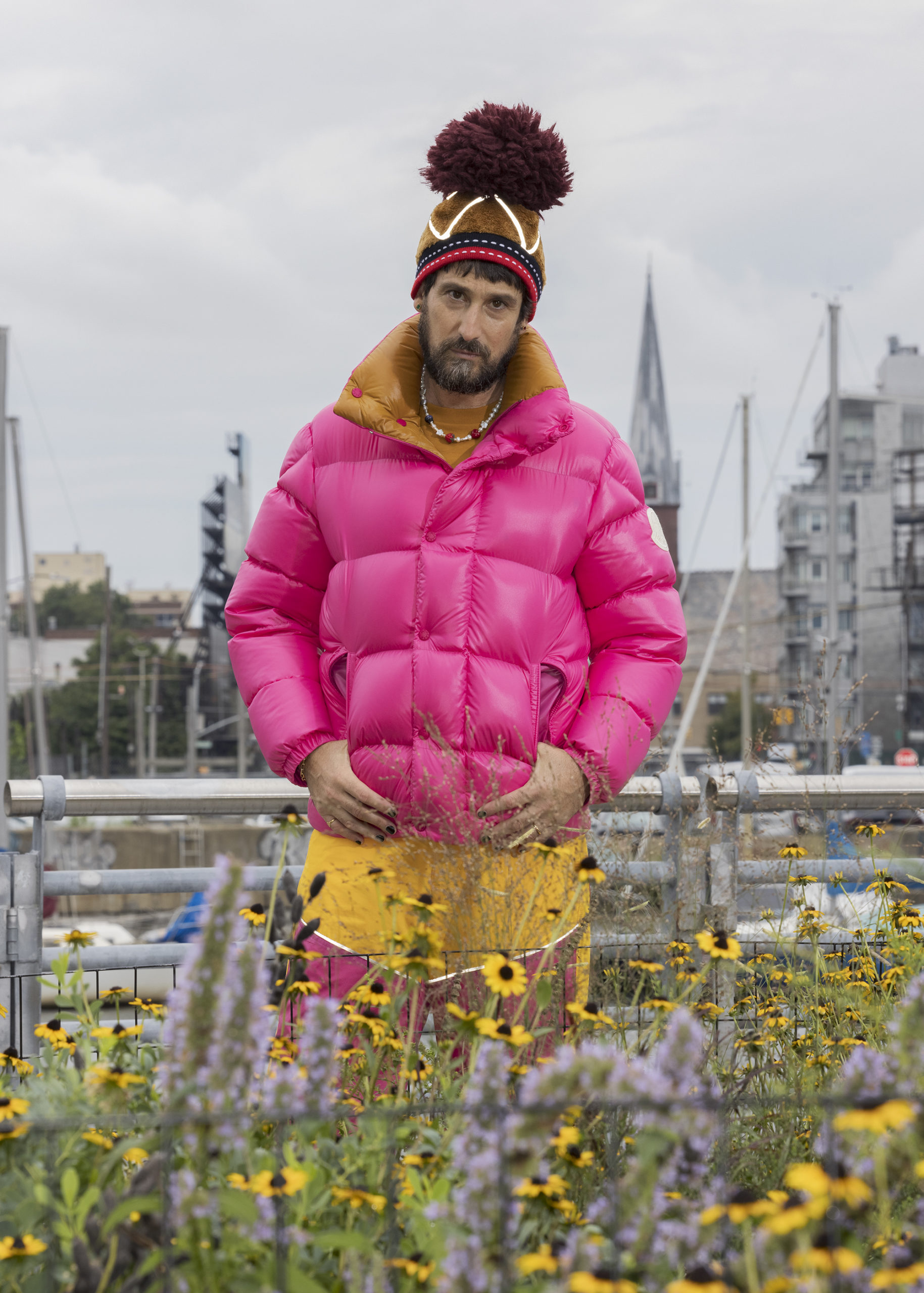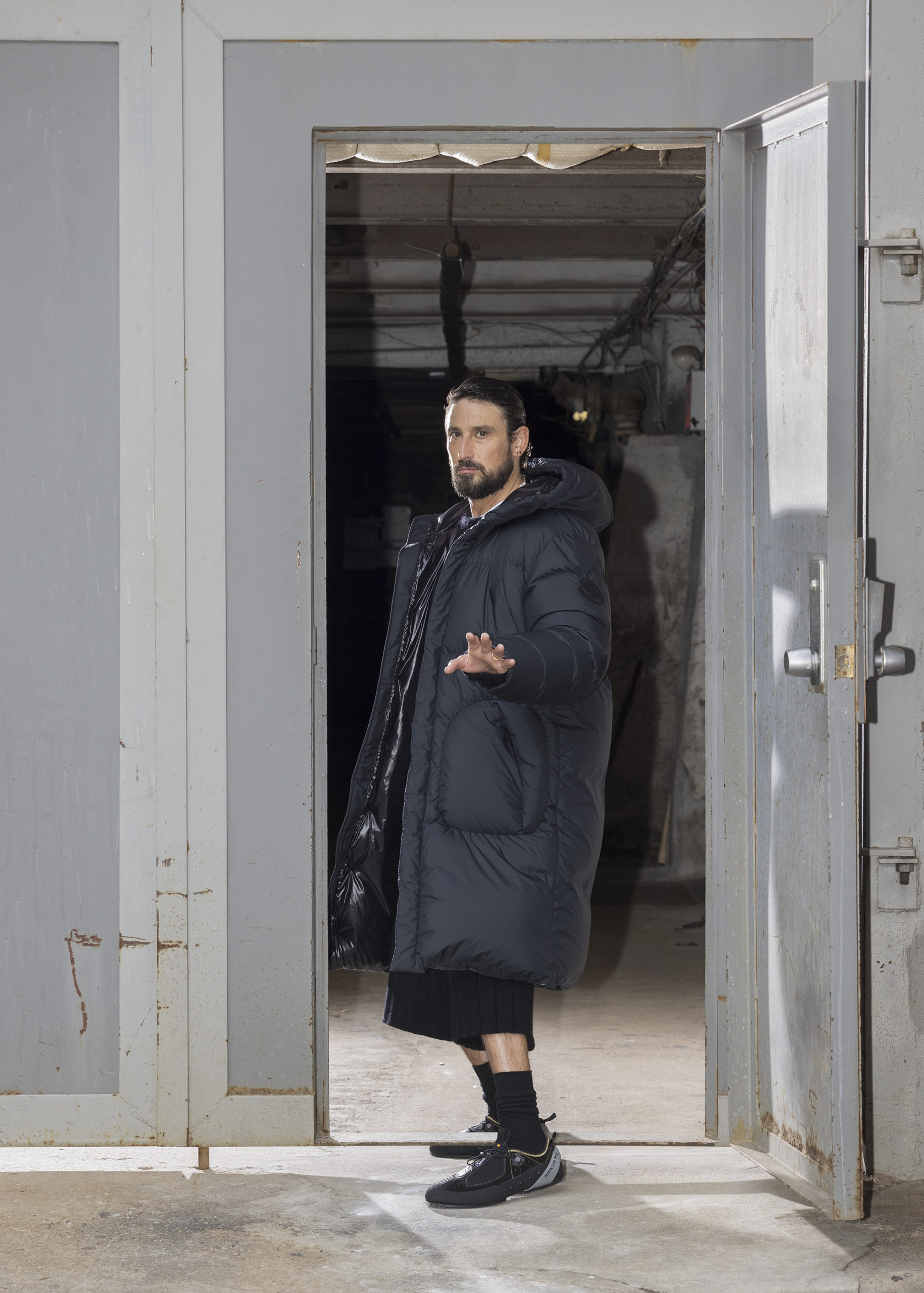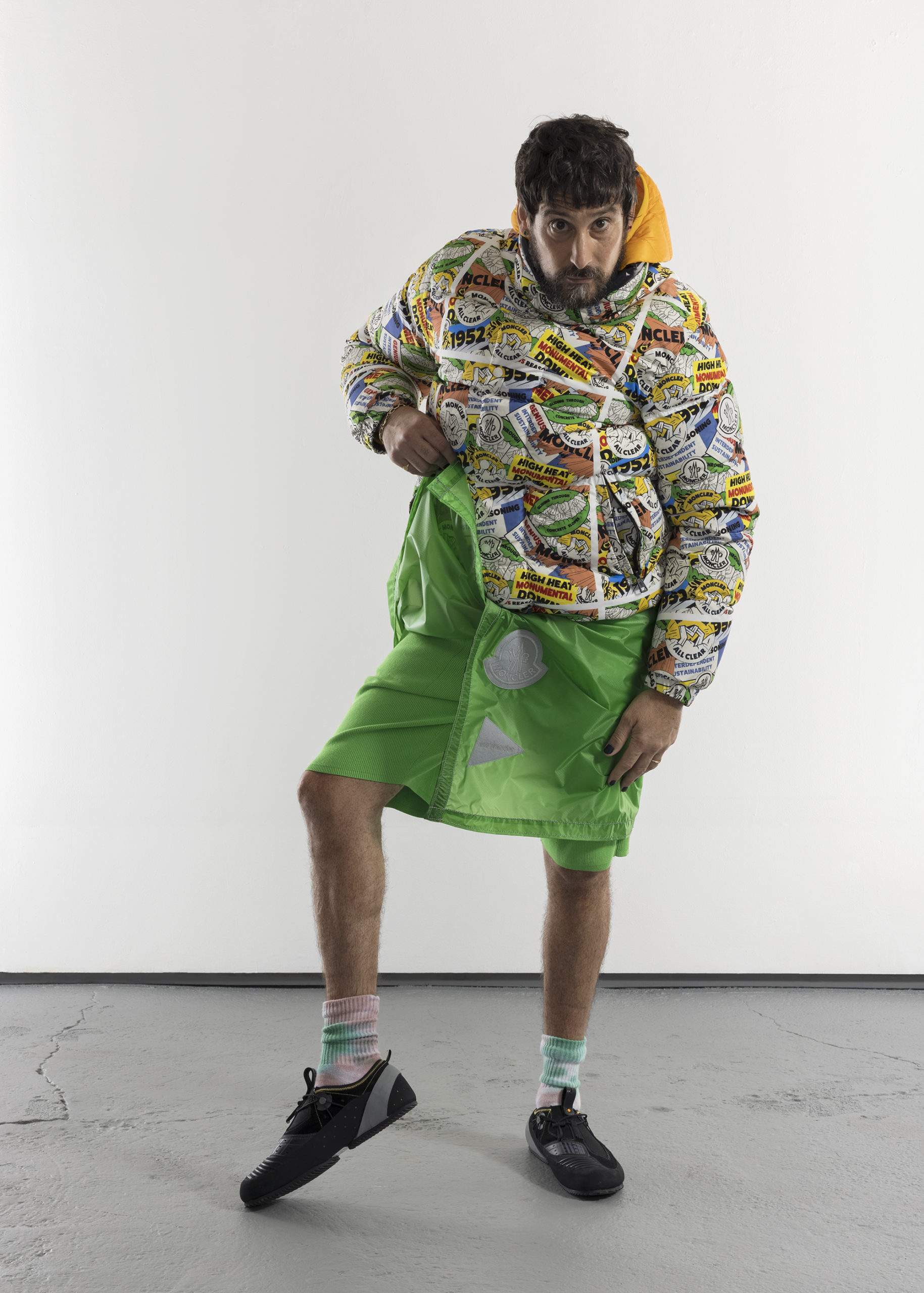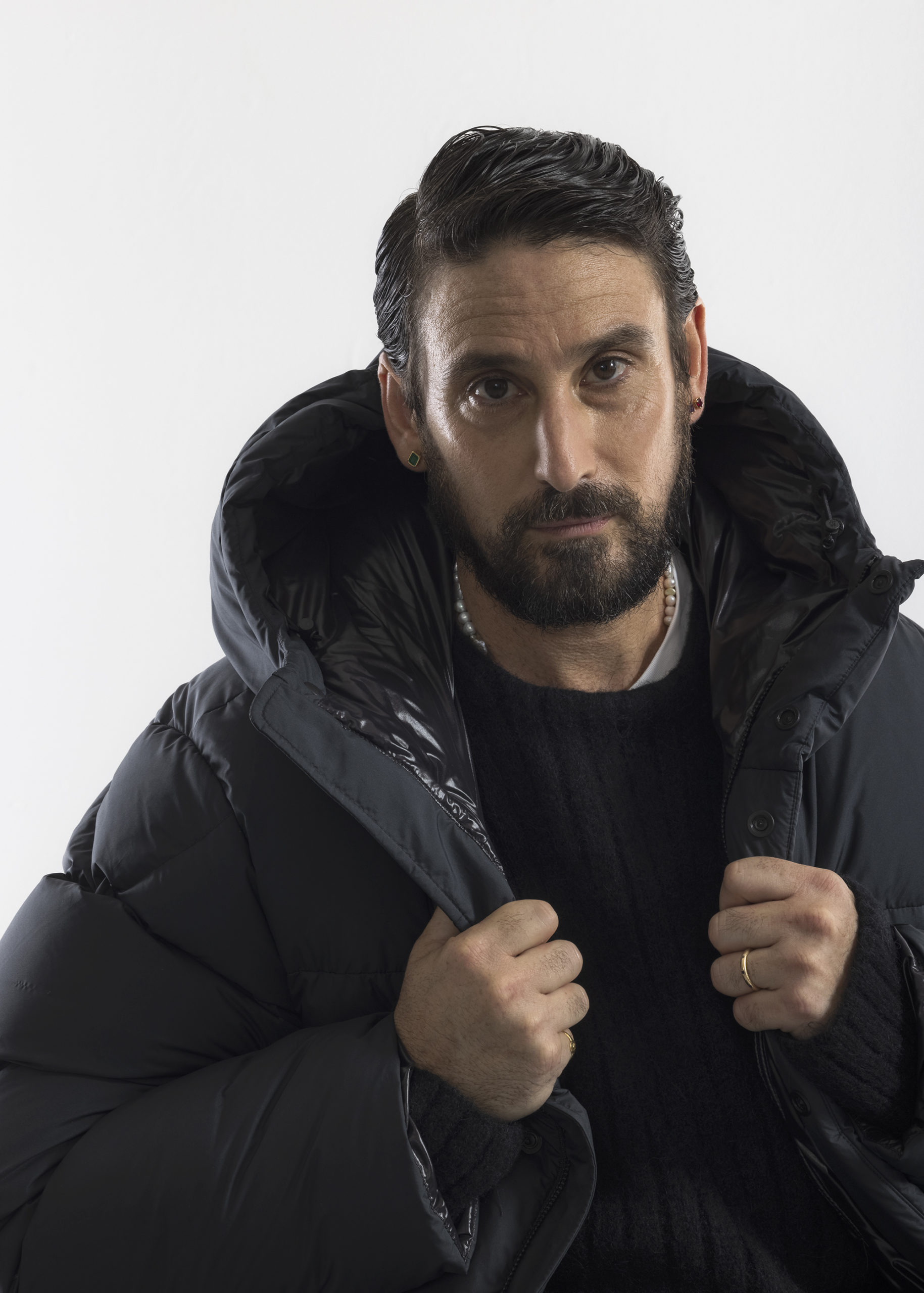IN CONVERSATION
Sergio Zambon and Mordechai Rubinstein Find Inspiration Underground

All clothing and shoes (worn throughout) by 2 Moncler 1952. Jewelry and socks (worn throughout) Mordechai’s Own.
SERGIO ZAMBON: Ciao, how are you? I’m very excited to have this conversation together after everything I read about you on Instagram.
MORDECHAI RUBINSTEIN: Don’t believe anything on Instagram. Well, the photographs you can believe. Those are real. Are you in Italy?
ZAMBON: Yeah, I’m in Milan. Are you in New York?
RUBINSTEIN: I actually escaped for the Rosh Hashanah New Year, but I’m still in the New York state of mind. You and Moncler have been collaborating with some of the best and coolest brands. I’m curious how you came across And Wander and Suicoke.
ZAMBON: I used to work at Fendi and I collaborated with a lot of people. When I started the first collection with Moncler, I began by collaborating with graphic artists and brands. Two seasons ago, I came up with the idea of collaborating with a city every Fall/Winter. I did the first season with Los Angeles, and for this season I chose Tokyo. I knew And Wander for a long time and I really like their sense of minimal, stylish streetwear and outerwear. It’s very detailed in an understated way. It’s very different from what I’m doing with Moncler, which is very pop, sporty, and colorful. With Suicoke, I’m attracted to the fast pop phenomenon. I’m shocked at how Suicoke became, in such a short period, as iconic as Birkenstock. Suddenly everyone knows them.

RUBINSTEIN: And Wander’s fabrics are genius. Also, personally, I’ve never worn a skirt before in my life and I’ve always wanted to. The Interview folks let me wear what I wanted to wear. It was a true collaboration. I was photographed for the first time in my life without a head covering, with nail polish, and with a skirt. It was so much fun. Not to give you more props, but it felt so natural to put it on. I assume you’ve been to Japan?
ZAMBON: Yes, I’ve been many times. I’m obsessed with big cities. I studied architecture for one year and, for me, Tokyo epitomizes the big city. I like the architecture and how intricate it is, but at the same time, it also has a natural, organic base. I like the sense of style. I sometimes see senior people in extremely elegant Japanese clothing and then, of course, there’s a wealth of street style. The attention to detail is incredible. I wanted to adopt that sophisticated approach in my work with Moncler.
RUBINSTEIN: What was your main inspiration for this collection?
ZAMBON: The collection is generally 30 to 35 outfits, and the collaboration is just a little part. So, the main idea, which has continued on from the first season, is the evolution of the pop style of Moncler. The style is much more eccentric. For example, there is a huge wool headscarf. There is a very big hat. These are the out-of-the-blue accessories we generally find in Tokyo.
RUBINSTEIN: You take a down vest that could look normal from any collection, but when it’s paired with that hat, it’s so Moncler. It really opened up my eyes. It’s so fresh. I don’t know everything about Moncler, but there are some incredible bubblegum pink colors, and different shades of yellow. How did you land on these shades of pink, yellow, and green?
ZAMBON: I really like working with colors. I was born in Egypt and grew up in different countries, so I absorbed the sense of color from different places. I started with the classic sporty colors of the ‘80s and reworked them. It’s a very strong part of my work. I’m not afraid of using color.

RUBINSTEIN: Why are colors important to you in a post-lockdown life?
ZAMBON: We don’t wear many colors as much as we wear black, blue, navy, army green, or khaki. I think colors, especially in the post-pandemic, give us a sense of joy, playfulness, and cheerfulness. It’s very important for this restart after the pandemic, which we are still in.
RUBINSTEIN: I completely agree. I grew up wearing only black and white, so when I discovered pink, yellow, tie-dye, and patterns, I was really let out of the zoo.
ZAMBON: What’s your ideal outfit?
RUBINSTEIN: I’m still discovering fabric and learning about how cashmere is a smart fabric. I’m so afraid of spilling maple syrup from my breakfast on my clothing, but at the same time, I love a stain because it’s like a souvenir or a tattoo. You know, I didn’t grow up wearing sweatpants. I grew up Hasidic Jewish, so I wore suits every day. But I love soft. Instead of cotton, I want corduroy. For me, it’s about comfort, but not looking comfortable. I do live for shock value, so I can’t wait for my friends and family to see me in a skirt. My ideal outfit is more about the fabric, I guess. I believe that a collared shirt is getting dressed. Wow, you really got me.
ZAMBON: I was surprised when you talk about referring to yourself as an anthropologist and garmentologist because I also kind of feel like that. I’d love to hear more from you.
RUBINSTEIN: I love to watch people and what they’re wearing. For example, a bus driver from the city of New York will put a paper towel with clips around their shirt. Now, you and I might not want to walk into a meeting with a napkin around our shirts, but there’s something so beautiful about it.
ZAMBON: I completely love these things. You can look and you can transform something in details or accessories.
RUBINSTEIN: I call it beauty and the everyday uniform.
ZAMBON: It’s kind of a Margiela way of thinking. I love to use public transportation. When I am in a city, whether it’s Lisbon or Copenhagen, I immediately want to go near the subway and look at people. Are there some places that are your favorites?
RUBINSTEIN: I have a dream of staying underground for 24-48 hours and just studying people. Obviously, what they’re wearing is most important to me, but I don’t know how long I would last. I also worked in concept design for a minute at Levi Strauss. My bosses would tell me, “You’re not just fascinated with clothes, you’re fascinated with people, too.” That’s when I looked into anthropology. As for being a garmentologist, I made it up, I’m not going to lie. The construction, whether it’s 22 stitches per inch or fully fashion, is great, but that doesn’t really translate to the customer enough. I wish there was more product knowledge, but they just look at a pink gown and see a pink gown. I would always tell these designers that come to New York to stay on the 4 train from Brooklyn to the Bronx and don’t get off. That’s the best education.

ZAMBON: I used to live on Essex Street for a certain period. I really liked it when it wasn’t so fashionable. I love the mix of real New York style.
RUBINSTEIN: Every neighborhood in New York used to have a uniform and a look. I mean really, all over the world. Is there even Tokyo style anymore? Between you and me, yeah there sure is. For most people, the trends are moving so fast.
ZAMBON: You know why there is a very strong Tokyo style? It’s a little bit less cosmopolitan.
RUBINSTEIN: I was just thinking how different it is from New York. In New York, you could hang out outside Grand Central, and you’ll see garbage men, doctors, and lawyers. In Tokyo, you could hang out outside a train station and there are way more different types of people. That Shibuya crossing where people take pictures at all day, I would like to spend a week documenting it in one corner.
ZAMBON: What do you think about Los Angeles?
RUBINSTEIN: I have a real problem with Los Angeles.
ZAMBON: [Laughs] I knew it.
RUBINSTEIN: A few years ago, friends of mine were moving from New York to L.A. Somebody claimed it was easier to be an artist there, so I kept asking people, “What does that mean?” I’m not really an artist. I don’t paint, I’m not really a photographer, I don’t drive. When I was working at Levis in San Francisco, everything was tomorrow. “We’ll get to it tomorrow.” In New York, it’s now. I couldn’t understand this “tomorrow, tomorrow, tomorrow.” But when I was studying the people, every guy was in jeans and flip-flops. I read an interview with you and it opened up my eyes to L.A. style a lot more, because you broke down about why it’s easier to be an artist there. It made some sense to me. I saw a book a few years ago about the ‘60s style of L.A. men, and they looked like gallerists and artists. They were so cool. I could go on forever.
ZAMBON: A friend of mine moved from New York to L.A. years ago, and he had a gallery. He said, “There’s no reason to dress up here, because you’re in your car.” Now, the comparison to Italy comes to mind. I am from Rome and the sense of colors in Rome and the south of Italy is much stronger than in Milan. They use much more color. Women in Rome will have red shoes and a red bag, while in Milan, it’s more discreet. I like to talk about the geographical differences of style.

RUBINSTEIN: I spent all these years of Fashion Weeks just going to Milan, so I’ve never been to Rome. I’ve been to Florence, and that’s different.
ZAMBON: Very different.
RUBINSTEIN: Yeah. I finally went to Osaka because people told me there are many more old people. It’s a unique style.
ZAMBON: I’ve been to Kyoto, which is a big difference. It’s the old Japan. It’s nice. I like to explore these things. I read once how colors in the U.S. are sold in a different way from California to New York. It’s very interesting.
RUBINSTEIN: Another thing that I think is interesting about the last couple of years, is that New York used to be so black, but now you see all these colors, patterns, and tie-dye. All of a sudden, I started seeing yellow and pink coats. It’s so good to breathe fresh energy in New York. It’s a nice change to see summer colors in the winter.
ZAMBON: The technical fabric and outerwear bring all of that color in winter. It was a transition that happened via sporty style.
RUBINSTEIN: I’m looking at my questions and want to make sure I don’t miss anything. Who inspires your creativity?
ZAMBON: When a season starts, I have an idea of the collection, which is generally a mixture of things. It can be sand boarding in Morocco mixed with the spirit of the ‘70s. So, the colors may be a mix of Moncler sport silhouettes and the folk-country look of the ‘70s. It’s never one thing, which is really related to my background. My mother is Croatian and my father is Italian. So, everything for me is about mixture.
RUBINSTEIN: What do you hope people feel when they wear this particular collection?
ZAMBON: [Laughs] Well, it’s very obvious. First of all, I hope they really like it and enjoy the sense of color and how pop it is.
RUBINSTEIN: The collection aims to bring the spirit of rest out of the domestic environment and into public life. Why was that an important aspect to highlight with this collection?
ZAMBON: There is a part of the collection that, for the first time, explores a minimal total look. Meaning, the whole look is done in one color. The concept is “resting out,” so you’ll see a tracksuit in knitwear. Indoor slippers are represented by the Suicoke sandals. You’re basically bringing your home with you outside, which was inspired by COVID and the pandemic.

RUBINSTEIN: I argue with myself all the time if Birkenstock and Suicoke sandals are acceptable for a man in New York City. I’m not making the rules, but New York subways are kind of disgusting. You could step on a rat, someone could step on your heel. Walking in a sandal is sometimes not the most responsible footwear, but it sure is comfortable. The Birkenstock and Suicoke in L.A. makes so much more sense to me.
ZAMBON: I remember once in New York at a club, I was wearing loafers. I don’t remember if it was a small rat or a cockroach, but it literally passed across my feet. I suggest a solution for these kinds of shoes in New York: wear Crocs with socks. [Laughs]
RUBINSTEIN: Or Suicoke with socks.
ZAMBON: Exactly.






